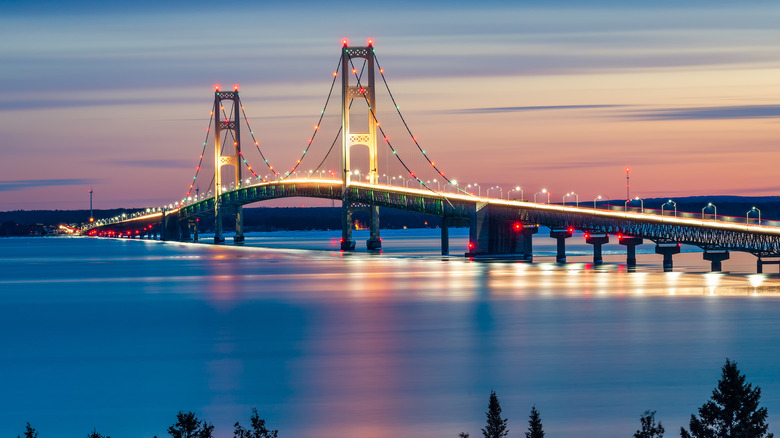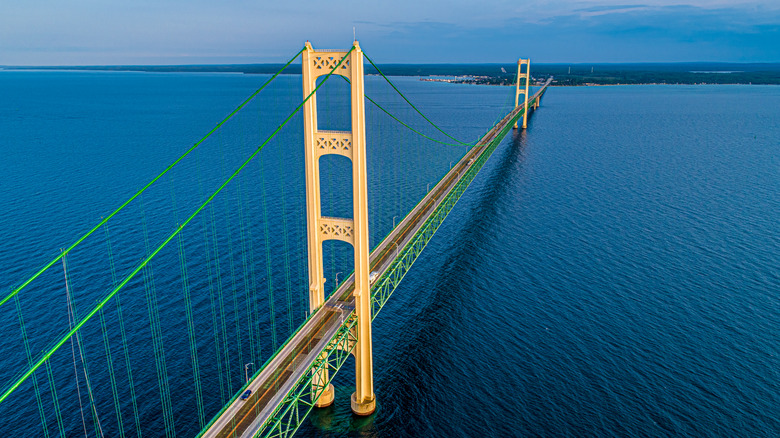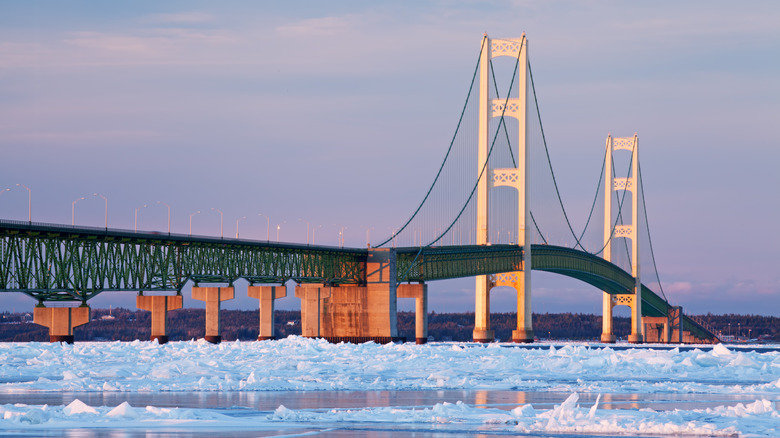Why Many Are Terrified Of This Iconic Michigan Bridge
There are many amazing bridges around the world, and Michiganders are justly proud of their Mackinac Bridge. Like the Golden Gate in San Francisco and the Brooklyn Bridge in New York, the "Mighty Mac" has become an inspiring symbol of the place it serves. Every Labor Day, it is closed to traffic so the public can enjoy it on foot, and it has been commemorated on U.S. postage stamps twice: Once in 1958 and again in 2010.
Linking the upper and lower peninsulas of Michigan, the Mackinac Bridge spans five miles across the choppy Straits of Mackinac, a body of water that connects Lake Huron and Lake Michigan, two of the Great Lakes. The possibility of a bridge between the two points was suggested as far back as 1884, and it took another 70 years before the required legislation and planning was passed and the immense project finally swung into action.
The logistical challenge of building a bridge of such length over the Straits was very hazardous, and five workers died during construction. The bridge opened on November 1, 1957, and at the time it was celebrated as the world's longest suspension bridge between anchorages, topping San Francisco's famed Golden Gate. Now, it is still the third-longest suspension bridge in the United States, and it is lauded as one of the most scenic bridges in the nation. Yet for all the affection and pride people feel for the Mackinac, it is also regarded as one of the world's most terrifying bridges.
Why is the Mackinac Bridge so scary?
A combination of factors makes the Mackinac Bridge a daunting prospect for some nervous drivers. The four lanes are narrow with no dividing barrier between traffic traveling in opposite directions, and the low protective guard rails offer little protection from the wind, which regularly tops 30 miles per hour. This can get even scarier during a snowstorm, when visibility and slippery conditions of the roadway make the crossing even more dramatic. The frequently gusty weather causes concern that vehicles might blow right off the side of the bridge.
Reaching a height of 199 feet above the water in the central section, the scenic view that makes the Mackinac such a treat for many can play havoc with the nerves of drivers who suffer from a fear of heights. Some prefer to stay away from the outer edge, but the inner lane also has a vertiginous view: Straight down through a grating to the cold water far below.
While many motorists traverse the Mackinac without any issues, some fearful travelers prefer to have someone else do the driving for them. This is such a common issue that the Mackinac Bridge Authority provides a Driver Assistance program. Available around the clock, the service costs $10 plus the usual toll for the bridge. For that money, a staff member from the Mackinac Bridge crew will safely chauffeur you to the other side while you take the passenger seat and try to enjoy the view.
Is there any real reason to fear the Mackinac Bridge?
Although windy conditions on the Mackinac Bridge have provoked rumors that motorists can get flipped off the roadway by a particularly strong gust, the Mackinac Bridge Authority has reassuringly quelled such fears. Per their website, over 200 million vehicles have crossed the bridge since it first opened, and nobody has ever been blown off the bridge. In all that time, only two vehicles have suffered the misfortune of going over the edge into the water below. In September 1989, a Yugo compact car exceeding the bridge's 45 mph speed limit jumped the guardrail, causing the death of the driver. High winds were thought to be a contributing factor in the accident. Another fatality occurred in March 1997 when a driver with a long history of traffic violations lost control of his Ford Bronco and plunged into the icy water 200 feet below. Police later determined that the man died by suicide.
After a cargo ship colliding with Baltimore's Key Bridge caused the structure to fatally collapse in March 2024, concerns were raised that other bridges around the nation could face a similar fate. Authorities at the Michigan Department of Transportation avoided getting drawn into speculation regarding the safety of the Mackinac Bridge, but a spokesperson from the Michigan State Police reassured motorists that they were prepared for such an occurrence. For now, the best advice to anyone crossing the bridge is to drive carefully and enjoy the scenery.


